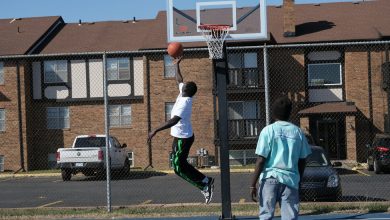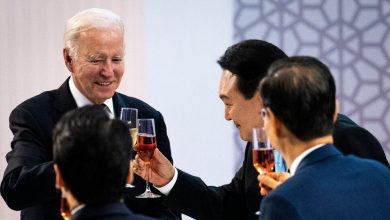A U.S.-Iran Soccer Showdown Intensifies With Protests as a Backdrop

When players representing Iran and the United States take the field at the World Cup in Qatar on Tuesday, millions of fans will be dissecting every move — not just passes, fouls and headers, but also whether the Iranian players sing the national anthem, celebrate any goals or speak about the protests shaking their country.
The game between the two longtime geopolitical foes, a key hurdle for both teams if they hope to advance to the next stage, has become yet another front line in the most significant challenge the Islamic Republic has faced since the 1979 revolution that brought it to power. And this time, it is all under the glaring lights of the most watched event in the world.
For 10 weeks, anti-government demonstrations have convulsed Iranian cities; the resulting crackdown has landed thousands of protesters in jail and killed hundreds more. That unrest has spilled into Iran’s two matches so far in Qatar, where spectators have booed the Iranian national anthem and waved flags with one of the slogans of the protests, “Woman, life, freedom,” only to be escorted out by security officials.
Pro-government Iranians have confronted and intimidated Iranian fans wearing protest gear outside the stadiums. By last weekend, even the United States Soccer Federation had leaped into the fray to support the protesters, scrubbing Iran’s official emblem and Islamic script off Iran’s red-white-and-green flag in images it posted on social media. It later deleted the posts after Iran’s soccer federation called for the American team to be expelled from the World Cup.
“Respecting a nation’s flag is an accepted international practice that all other nations must emulate,” Safia Allah Faghanpour, a legal adviser to Iran’s soccer federation, said in comments reported by a semiofficial state news agency in Iran, skirting the fact U.S. flags are commonly desecrated at pro-government demonstrations in Iran.
Now the main question is what Team Melli, as Iran’s squad is affectionately known to fans around the world, will do with its next turn on the field: Please the government that sponsors it by keeping strictly to sports, or win the hearts of the opposition on the streets. Whatever it does, winning or holding the United States to a draw, either of which will advance them to the next round, will put Iran’s domestic strife in front of a huge global audience for at least a few days longer.
“This is why U.S.A. versus Iran is going to be the most significant and politically charged match in the history of the World Cup,” said Omid Djalili, an Iranian-British actor and comedian who has closely tracked the team, combining a fan’s passion with an activist’s fervor.
He insisted this was no hyperbole: “The further they get in the tournament, the more interest there will be in these protests,” he said of the Iranians. “The regime can spin this any way they want — the globe will see what’s going on.”
Offering no hint of solidarity with the protests could alienate millions of fans, many of whom have rejected the players as instruments of a despised regime. But actions like refusing to sing the anthem risk penalties back home.
A Brief Guide to the 2022 World Cup
What is the World Cup? The quadrennial event pits the best national soccer teams against each other for the title of world champion. Here’s a primer to the 2022 men’s tournament:
Where is it being held? This year’s host is Qatar, which in 2010 beat the United States and Japan to win the right to hold the tournament. Whether that was an honest competition remains in dispute.
When is it? The tournament opened on Nov. 20, when Qatar played Ecuador. Over the two weeks that follow, four games will be played on most days. The tournament ends with the final on Dec. 18.
Is a winter World Cup normal? No. The World Cup usually takes place in July. But in 2015, FIFA concluded that the summer temperatures in Qatar might have unpleasant consequences and agreed to move the tournament to the relatively bearable months of November and December.
How many teams are competing? Thirty-two. Qatar qualified automatically as the host, and after years of matches, the other 31 teams earned the right to come and play. Meet the teams here.
How does the tournament work? The 32 teams are divided into eight groups of four. In the opening stage, each team plays all the other teams in its group once. The top two finishers in each group advance to the round of 16. After that, the World Cup is a straight knockout tournament.
How can I watch the World Cup in the U.S.? The tournament will be broadcast on Fox and FS1 in English, and on Telemundo in Spanish. You can livestream it on Peacock, or on streaming services that carry Fox and FS1. Here’s how to watch every match.
When will the games take place? Qatar is three hours ahead of London, eight hours ahead of New York and 11 hours ahead of Los Angeles. That means there will be predawn kickoffs on the East Coast of the United States for some games, and midafternoon starts for 10 p.m. games in Qatar.
Got more questions? We’ve got more answers here.
Last week, a star member of Iran’s 2018 World Cup team, Voria Ghafouri, was arrested and charged with “propaganda against the Islamic Republic and insulting the national football team” after speaking in support of the protesters and calling on the government to stop killing Kurds, the ethnic minority to which he belongs. Mr. Ghafouri was passed over for the World Cup team earlier this year, leading fans to conclude he was being punished for his activism.
Mr. Ghafouri was released on Monday, according to state media. But other celebrities and athletes remain in prison or have been forced to recant publicly after expressing support for the protests.
“To make them the only people that they need to give you answers about the human being problems all over the world,” Carlos Queiroz, Iran’s coach, said at a news conference on Thursday, “I don’t think it’s fair.”
Iran’s leaders have claimed the team as their own, using its success to whip up national pride and project strength and unity.
They have also had help in tamping down political statements at the tournament. Security officials from Qatar, with which Iran enjoys mostly friendly ties, have confiscated some protest-themed gear at the matches, and FIFA, world soccer’s governing body, has banned political protests by teams and certain controversial flags, including Iran’s pre-Islamic Republic flag.
An Iranian newspaper close to the reformist political faction, Hamdeli, reported on Monday that hundreds of government officials and supporters had traveled to the World Cup at public expense to cheer Iran on. It is not clear if they are the same pro-government fans who clashed with anti-government ones outside stadiums last week.
Before Team Melli left for Qatar, state media broadcast images of the players meeting Iran’s ultraconservative president, Ebrahim Raisi, who posed for pictures with the team holding a jersey with his name printed on the back. At least one player bowed.
Many of the protesters and their supporters in the Iranian diaspora immediately turned on the players, a measure of the bitter depths of the Iranian opposition’s with-us-or-against-us mind-set. They would not root for a team of regime shills, they said.
“I hate it that the regime even took football away from us,” said Nima, a soccer fan from Tehran who has taken part in the protests. “I can’t even enjoy cheering for the national team without any hesitation because of all the things they have done.”
Others have found themselves torn, or won over, after the team’s gestures of solidarity.
After Iran’s national team went noticeably mute during their national anthem at their first match, a 6-2 drubbing by England, Kayhan, an Iranian newspaper linked to the country’s supreme leader, was scathing.
“Iran 2 — England, Israel, Saudi Arabia and domestic and foreign traitors 6,” its headline read, naming a few of Iran’s main enemies. It lambasted the players as “without honor” for refusing to sing the anthem.
When they beat Wales 2-0 in their next game, on Friday, the players mouthed or mumbled the anthem, “a choir of damned if they do, damned if they don’t,” as the Guardian’s soccer correspondent, Andy Hunter, put it.
But it was apparently good enough for Kayhan. “Iran 2 — Wales, Israel, Saudi Arabia and domestic and foreign traitors 0,” its new headline read. After the match, members of Iran’s security forces — the same riot police and paramilitary volunteers who have violently, sometimes fatally suppressed the protests — were photographed dancing atop anti-riot vehicles in their tactical gear, waving guns in one hand, flags in the other.
During the tournament, the players have spoken sympathetically about the protests several times, and posted messages on social media expressing solidarity with the people of Iran.
“This goal was a gift for my people in Iran,” Ramin Razaeean, who scored against Wales in the 101st minute to seal the win, said afterward. “Especially,” he added, those “who are suffering.”
Nima, the soccer fan from Tehran, said the players should have gone further by miming haircuts on the field, as an Iranian beach soccer athlete did recently, in solidarity with female protesters who tore off their hijabs and cut their hair in the recent protests.
Though he was “shouting with joy” when Iran scored the winning goal against Wales, he said, he felt he could not truly enjoy the victory because security forces were celebrating it, too. “They ridicule us with these gestures,” he said. “The same forces kill innocent people, kill children in the streets.”
There is always plenty of heat between the United States and Iran, two countries that ripped up formal diplomatic relations after the 1979 hostage crisis in Tehran, where chants of “Death to America” are practically a government slogan and U.S. sanctions have helped cripple Iran’s economy. But Iranians are now chanting “death to the dictator” against their own leaders, enraged with their government’s repression, violence, corruption and restrictions on everything from dress to political freedoms.
When the United States and Iran met for the first time at the 1998 World Cup in France, Iranian players helped defuse the geopolitical unease by handing white roses, a symbol of peace, to the American players before the match. But domestic strife still hung over the game.
Several thousand Iranian fans smuggled T-shirts and banners into the stadium that bore the faces of two leaders of a Paris-based Iranian dissident group, jubilantly waving the banners at halftime as the public-address system played the Macarena.
After Iran won 2-1, Ayatollah Ali Khamenei, the supreme leader, claimed victory for the Islamic Republic. “Tonight again,” he said on state television, “the strong and arrogant opponents felt the bitter taste of defeat at your hands.”
Jeré Longman contributed reporting.




